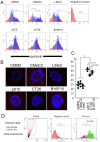Detection of bimodal survivin expressions in canine cancer types by flow cytometry compared to immunohistochemistry
- PMID: 40212948
- PMCID: PMC11984292
- DOI: 10.3389/fvets.2025.1552415
Detection of bimodal survivin expressions in canine cancer types by flow cytometry compared to immunohistochemistry
Abstract
Animal practice requires both convenience for the owner and risk management for the animal's health. Deterioration due to cancer may associate with poor prognosis under general anesthesia, which need to partial excision for pathological diagnosis. This study aimed to establish rapidly detecting the expression of survivin antigens for cancer vaccines or molecular targeted therapies via flow cytometry (FCM) using the intracellular staining method in tumor samples obtained via needle biopsy without anesthesia. Therefore, survivin expression patterns in each cell lines of canine melanomas, a murine mast cell tumor, a murine colon carcinoma, and a murine melanoma was analyzed by FCM and immunofluorescence microscopy, and compared with immunohistochemical analysis and western blot method. Interestingly, FCM results of the bimodal expression pattern of survivin were suggested to reflect the high fluorescence intensity of its nuclear-cytosol localization and the weak fluorescence intensity of its cytosol alone localization. In a case of canine cancer disease, it was confirmed that survivin expression patterns can be detected via FCM using needle biopsy samples in actual clinical settings. In this study, a novel method via FCM was proposed to quickly determine also survivin localization not only whether the survivin is expressed in cancer cells. The application of cancer vaccine or chemical therapy via this technology can be expected to contribute to improved animal care due to the "one-day first program," which has been proposed in convenience for owners.
Keywords: B16F10; CMM2; CMeC2; CT26; LMeC; flow cytometry; p815; survivin.
Copyright © 2025 Tsumoto, Tamura, Nakazawa, Fujita and Ohkusu-Tsukada.
Conflict of interest statement
The authors declare that the research was conducted in the absence of any commercial or financial relationships that could be construed as a potential conflict of interest.
Figures



Similar articles
-
Inhibition of skin squamous cell carcinoma proliferation and promote apoptosis by dual silencing of NET-1 and survivin.Oncol Rep. 2015 Aug;34(2):811-22. doi: 10.3892/or.2015.4062. Epub 2015 Jun 15. Oncol Rep. 2015. PMID: 26080853
-
[Molecular mechanism of anti-apoptotic action of survivin in NCI-H446 lung cancer cells].Zhonghua Zhong Liu Za Zhi. 2006 Jun;28(6):413-7. Zhonghua Zhong Liu Za Zhi. 2006. PMID: 17152484 Chinese.
-
Expression and targeting of the apoptosis inhibitor, survivin, in human melanoma.J Invest Dermatol. 1999 Dec;113(6):1076-81. doi: 10.1046/j.1523-1747.1999.00776.x. J Invest Dermatol. 1999. PMID: 10594755
-
Suicide gene therapy for hepatocellular carcinoma cells by survivin promoter-driven expression of the herpes simplex virus thymidine kinase gene.Oncol Rep. 2013 Apr;29(4):1435-40. doi: 10.3892/or.2013.2248. Epub 2013 Jan 24. Oncol Rep. 2013. PMID: 23354806 Free PMC article.
-
Survivin and Sox9: Potential Stem Cell Markers in Canine Normal, Hyperplastic, and Neoplastic Canine Prostate.Vet Pathol. 2019 Mar;56(2):200-207. doi: 10.1177/0300985818794161. Epub 2018 Aug 21. Vet Pathol. 2019. PMID: 30131013
References
LinkOut - more resources
Full Text Sources

